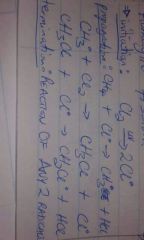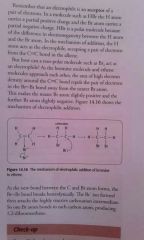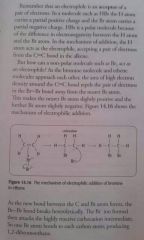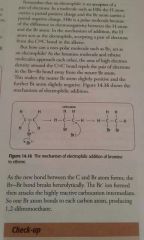![]()
![]()
![]()
Use LEFT and RIGHT arrow keys to navigate between flashcards;
Use UP and DOWN arrow keys to flip the card;
H to show hint;
A reads text to speech;
27 Cards in this Set
- Front
- Back
- 3rd side (hint)
|
Explain the 3 types of structural isomerism |
1.chain-diff no. of C atoms in a straight chain 2.positional-change in pos of functional group 3.functional group-diff functional group |
Same molecular formula |
|
|
Define sterioisomerism |
Difference in orientation in space |
Same molecular formula |
|
|
Give 3 conditions for cis-trans isomerism to occur |
1.each C atom must hv 2 diff groups for rotation to be detectable 2.must be restricted rotation 3. Across C=C double bond |
|
|
|
What's optical isomerism? |
It occurs only when 4 diff alkyl groups are attached to the same C atom |
when does it occur |
|
|
Give 4 conditions for optical isomerism to take place(marking points) |
1.Chiral carbon 2.Asterisk on Chiral carbon 3.3D illustration 4.Correct reflection |
|
|
|
What are alkanes? Why are they unreactive? |
-Saturated hydrocarbons -unreactive bcz they are saturated |
|
|
|
What 2 types of reaction do alkanes undergo? |
FREE RADICAL SUBSTITUTION COMBUSTION |
|
|
|
What conditions are necessary for free radical substitution of an alkane to occur |
UV light for initiation step |
|
|
|
By what process do free radicals form? |
Homolytic fission |
Breaking of a covalent bond |
|
|
Example of free radical substitution -shortened |

|
3 steps |
|
|
Is combustion of alkanes exo/endothermic? |
Highly exothermic |
|
|
|
What's the importance of cracking alkenes? |
More useful small alkane molecules are formed and polyalkenes formed and used as feed stock and used to make Hydrogen for haber process |
|
|
|
Example of cracking: Undecane->heptane + ethene. What's the reagent? What are the conditions? |
Reagent:Undecane(alkane being cracked ) Conditions: Al2Cl3/SiO3 catalyst Strong heating (500'C) |
|
|
|
When Cl2 is used in free radical substitution of alkanes, what happens if more Cl2 is added? |
Further substitution is possible from e.g. tetrachloro- to pentachloro- to hexachloro-... |
|
|
|
What is an alkene? |
Unsaturated hydrocarbon |
|
|
|
What products are formed when alkenes react with aqueous halogens? Reagents? Conditions? |
Halogen alcohol + dihalogenoalkanes
E.g C3H6 + Br2 (aq)-> Bromopropan-2ol[CH3CH (OH)CH2Br] + dibromopropane.[CH3CHBr (CH2Br)] Reagents:aqueous Br2 Conditions:RT and Ethanol as co-solvent |
|
|
|
Explain the formation of bromoalcohol from the reaction of alkenes with aqueous halogens. |

|
|
|
|
What type of addition do Alkenes generally undergo? |
Electrophilic |
|
|
|
What's an electrophile |
Electron-deficient |
|
|
|
What is a nucleophile |
Electron-rich |
|
|
|
What is heterolytic fission? |
Breaking of covalent bond in such a way that 1 atom take both electrons from the bonds making it negative and leaving the other positively charged |
|
|
|
What is homolytic fission |
Formation of free radicals |
|
|
|
When alkenes undergo Electrophilic addition, What are the reagents? Conditions? Products? Mechanism?
|

Reagent:HBr in ether solution OR pure HBr Conditions :RT Products:bromoALKANE
Mechanism is similar to that of adding Br2 |
|
|
|
State the reagent, conditions and mechanism when Br2, a halogen, is added to an alkene |

Reagent:pure Br2/Br2 in CCl4 solvent Conditions:RT Mechanism:same as with aqueous halogen. |
|
|
|
When steam is reacted with an alkene, what catalyst is used? Give reagents and conditions. |
Phosphoric acid catalyst An ALCOHOL is formed reagent-steam Conditions - H3PO4 catalyst Strong heating Pressure |
|
|
|
Alkene + Hydrogen->..... Complete the above reaction What catalyst is used? What's the reagent? What are the conditions? |
Nickel catalyst An ALKANE is formed Reagent:H2 gas Condutions:Ni catalyst Heat (150) |
|
|
|
When an alkane is oxidized by Mn04-(manganate (7)) ions, What are the products? Explain mechanism. Reagent and conditions. Observations. |
Product: Alkane-1,2-idol or A DIOL . mechanism: alkene + H2O + [O]-> alkane-1,2-diol Reagent-aqueous KMnO4 Conditions-Cold, dilute RT Observation: purple solution turns colourless |
|

